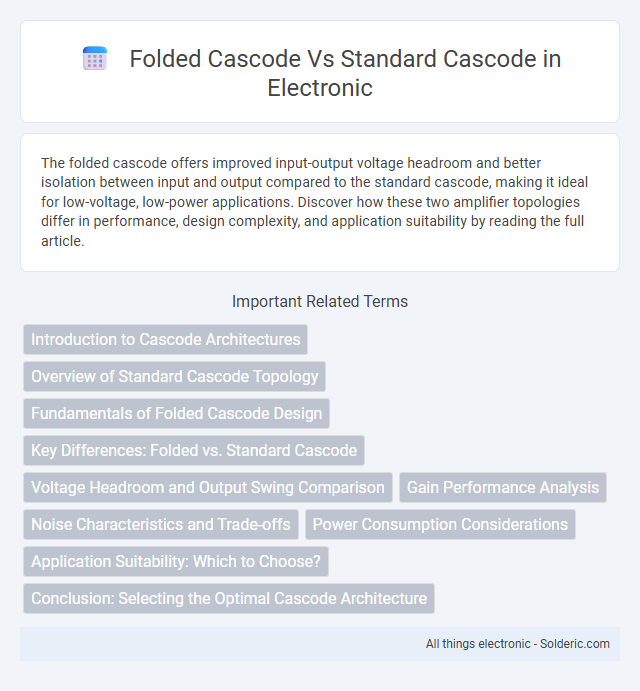The folded cascode offers improved input-output voltage headroom and better isolation between input and output compared to the standard cascode, making it ideal for low-voltage, low-power applications. Discover how these two amplifier topologies differ in performance, design complexity, and application suitability by reading the full article.
Comparison Table
| Aspect | Folded Cascode | Standard Cascode |
|---|---|---|
| Topology | Folded signal path using complementary devices | Stacked transistors in series (common-source + common-gate) |
| Voltage Gain | High voltage gain, slightly less than standard cascode | Very high voltage gain |
| Output Voltage Swing | Higher output voltage swing, improved headroom | Limited output swing due to stacked devices |
| Input Common-Mode Range | Better input common-mode range | Narrow input common-mode range |
| Power Consumption | Typically higher due to complementary devices | Lower power consumption |
| Output Impedance | High output impedance | Very high output impedance |
| Applications | Low-voltage, low-power analog front-ends | High-gain, low-noise amplifiers |
| Complexity | More complex layout and biasing | Simpler design and biasing |
Introduction to Cascode Architectures
Cascode architectures enhance amplifier performance by combining a common-emitter stage with a common-base stage, providing high gain and improved frequency response. The folded cascode differs from the standard cascode by folding the output current into a different branch, allowing for higher output voltage swing and better input-output isolation. Your choice between folded and standard cascode depends on specific design requirements like voltage headroom, gain, and power consumption.
Overview of Standard Cascode Topology
The standard cascode topology consists of a common-emitter (or common-source) transistor stage cascaded with a common-base (or common-gate) transistor, enhancing gain and bandwidth by reducing the Miller effect. This arrangement offers higher output impedance and improved frequency response, making it ideal for high-frequency analog circuit applications. Its simplicity and robustness support low noise performance and high voltage gain in amplifier design.
Fundamentals of Folded Cascode Design
Folded cascode design fundamentally improves the standard cascode by permitting input and output transistors to operate at different voltage domains, enhancing voltage headroom and maximizing gain in low-voltage environments. Your analog circuit benefits from reduced voltage drops and improved frequency response due to the folded architecture, which converts current efficiently while minimizing parasitic capacitances. This design approach is critical in modern low-power applications demanding high gain and wide bandwidth without compromising device performance.
Key Differences: Folded vs. Standard Cascode
Folded cascode circuits differ from standard cascode designs by incorporating a folded transistor stage that shifts the signal path, enabling lower voltage operation and improved input-output impedance matching. Standard cascodes provide higher gain and bandwidth due to their straightforward stacked transistor configuration but require higher voltage headroom. Your choice between folded and standard cascode depends on the trade-off between voltage constraints and the demand for gain and frequency performance in your circuit design.
Voltage Headroom and Output Swing Comparison
Folded cascode amplifiers provide improved voltage headroom compared to standard cascode stages, making them more suitable for low-voltage applications. The output swing in folded cascode configurations is generally larger due to the folding of the current path, which reduces the voltage drop across the cascode device stack. Standard cascode amplifiers have higher gain but exhibit reduced output swing and voltage headroom because of the additional voltage drop across the cascoded transistors.
Gain Performance Analysis
Folded cascode amplifiers provide moderate gain performance with improved output voltage swing and lower voltage headroom requirements compared to standard cascodes, which typically offer higher gain due to their higher intrinsic gain and better output impedance. The gain of a standard cascode is generally superior because of its high output resistance, but folded cascodes are preferred in low-voltage applications where maintaining gain while operating at reduced supply voltages is critical. Design trade-offs between gain and voltage compliance dictate the choice, with folded cascodes balancing gain performance and voltage headroom effectively for modern CMOS technologies.
Noise Characteristics and Trade-offs
Folded cascode amplifiers offer improved input-referred noise performance compared to standard cascodes due to their reduced flicker noise contribution and better transistor operating points. However, this noise reduction comes with a trade-off of increased power consumption and slightly lower gain-bandwidth product. Your choice between folded and standard cascode topologies should balance the noise performance requirements against power efficiency and frequency response constraints.
Power Consumption Considerations
Folded cascode amplifiers typically consume more power than standard cascode configurations due to additional biasing and current mirrors required for level shifting. Standard cascodes offer lower power consumption by directly stacking transistors, minimizing voltage headroom and current path complexity. Power efficiency in folded cascodes improves in low-voltage applications where voltage headroom constraints make standard cascodes less feasible.
Application Suitability: Which to Choose?
Folded cascode amplifiers are preferred in low-voltage and low-power applications due to their ability to operate with reduced voltage headroom while maintaining high gain and bandwidth. Standard cascode circuits excel in high-frequency scenarios where high output impedance and increased gain are critical, making them suitable for RF and analog front-end designs. Selecting between folded and standard cascode depends on specific design constraints such as supply voltage, power consumption, and frequency requirements.
Conclusion: Selecting the Optimal Cascode Architecture
The choice between folded cascode and standard cascode architectures depends on specific design goals such as voltage headroom, gain, and bandwidth. Folded cascodes offer better voltage swing and easier interfacing in low-voltage applications, while standard cascodes provide higher gain and improved output impedance. Optimizing the cascode design requires balancing these trade-offs to achieve the best performance for a given analog circuit.
Folded cascode vs Standard cascode Infographic

 solderic.com
solderic.com